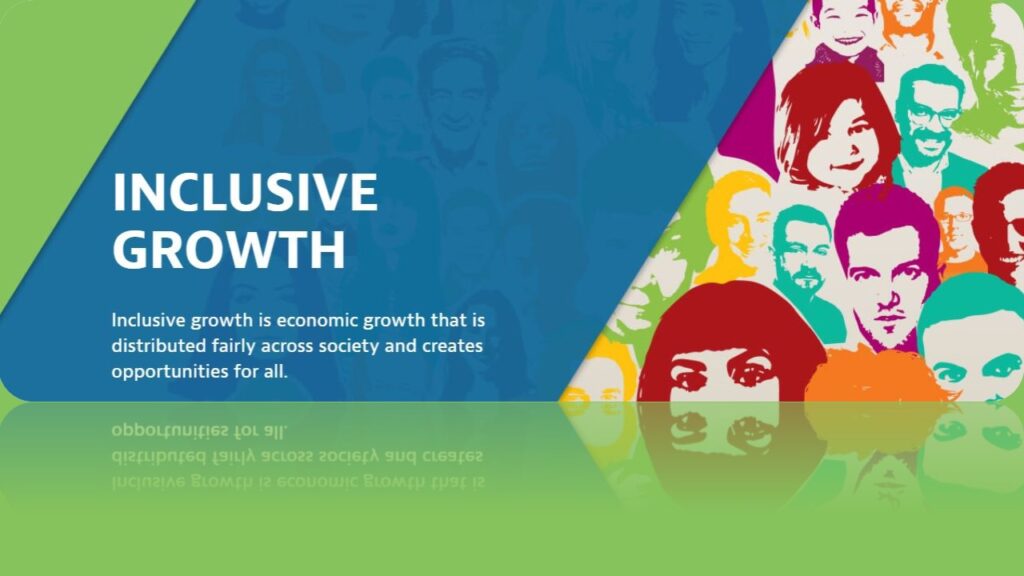Concept of inclusive development and measuring inclusive development as well as understanding the main meaning of inclusive development is essential for every student. It is necessary for any country and nation to move ahead with the inclusive development in the present time.
Points to be covered
- Concept of inclusive growth (IG)
- Status in India?
- Need for IG
- Pillars and Model of IG
- Issues concerning IG
- Initiatives of Gol in IG
What is Inclusive growth?
• Inclusive growth basically means, “broad based growth, shared growth, and pro-poor growth”
• “Inclusive Growth refers both to the pace and pattern of growth, which are interlinked and must be addressed together”- World Bank
• “IG is the process and the outcome where all groups of people have participated in the organization of growth and have benefited equitably from it”- UNDP
• The central idea-sharing of fruits of socio-economic development with all sections of the society
Components of Inclusive Growth
- Development in Agriculture
- Employment
- Poverty reduction
- Protection of environment
- Industrial and social sector development
- Reduction of income disparities
- Reduction of regional disparities
Has India achieved IG?
- Largest population living in extreme poverty – 224 mn
- Largest hungry population – 194 million
- Sanitation level
- Employment
- Literacy level
- Financial Inclusion
- Access to electricity
Need for Inclusive Growth in India
- India is the 7th largest country by area and 2nd by population. It is one of the largest economy at market exchange rate as well as at PPP
- India is suffering from low development in social indicators like malnutrition, poverty, lower literacy rates, sanitation problems, corruption etc
- India is suffering from unsatisfactory growth in economic indicators like GDP, Industrial Production, Development of infrastructure etc
- Although there is higher GDP growth being achieved, the fruits of that are not reaching all the people.
Model of Inclusive Growth
| Government |
Sustainable growth leading to productive jobs |
Inclusive Growth |
| Inclusion to provide access-investment in education, health or assuring level playing field | ||
| Social safety nets to protect the chronically poor |
IG – 4 Pillars
1. Growth & Economic Opportunity
- Growth rate of GDP per capita at PPP
- Employment rate
- Per capita consumption of electricity
2. Social Inclusion
- School life expectancy
- Pupil-teacher ratio
- Government expenditure on education as percentage of total government expenditure
- Gender parity in labor force participation
- Percentage of population with access to electricity etc
3. Social Safety Nets
- Social security expenditure
- Government expenditure on social security and welfare as percentage of total government expenditure
- Social protection etc
4. Good Governance and Institutions
- Accountability
- Government effectiveness
Issues related to IG
- Growth vs. Development debate
- Defining Poor is tricky
- LPG has favoured only the private companies and the rich
- Social Infrastructure development has been neglected
- Need to boost Technology and Innovation
- Social disparity is not reducing at a faster pace
Reforms by Govt
- MUDRA Yojana
- PMJJBY
- PMSBY
- APY
- JDY
- SAGY
- NESA
HDI – UNDP
Human Development Index (HDI)
| DIMENSIONS | Long and healthy life | Knowledge | A decent standard of living |
| INDICATORS | Life expectancy at birth | Mean years of schooling / Expected years of schooling | GNI per capita (PPP $) |
| DIMENSION INDEX | Life expectancy index | Education index | GNI index |
| Human Development Index (HDI) | |||
WEF – The Inclusive Growth and Development Report
Inclusive Growth and Development Framework
Pillar 1: Education and Skills Development :- [Access > Quality > Equity]
Pillar 2 Employment and Labor Compensation :- [Productive Employment > Wage and Non-wago Labor Compensation]
Pillar 3: Asset Building and Entrepreneurship :- [Small Business Ownership > Home and Financial Asset Ownership]
Pillar 4: Financial Intermediation of Real Economy Investment :- [Financial System Inclusion > Intermediation of Business Investment]
Pillar 5: Corruption and Rents :- [Business and Political Ethics > Concentration of Rents]
Pillar 6: Basic Services and Infrastructure :- [Basic and Digital Infrastructure > Health-related Services and Infrastructure]
Pillar 7: Fiscal Transfers :- [Tax Code > Social Protection]

